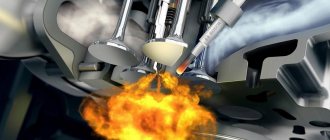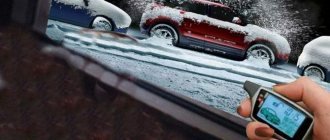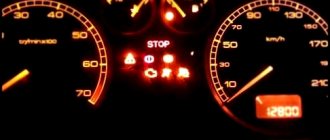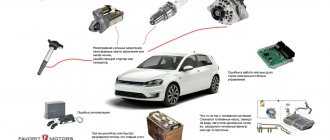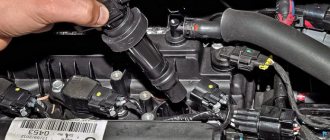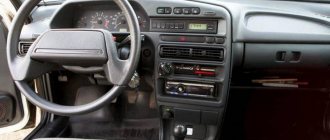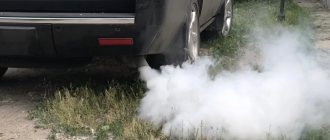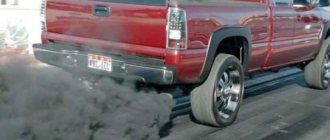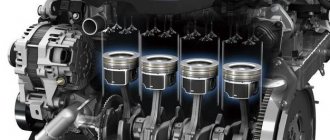string(10) “error stat” string(10) “error stat”
Diesel is the second most popular internal combustion engine. Its widespread use is primarily due to its cost-effectiveness. However, problems often arise when servicing the power unit. One of them is poor starting in the cold season. The reason why a diesel engine has trouble starting can be either poor fuel or a malfunction of various systems and components. Let's take a closer look at why this happens and what causes it.
Winter…
Fuel filter clogged
You can find out in advance that the fuel does not completely enter the combustion chambers. There are many signs that indicate that the fuel filter needs cleaning or replacement:
- increased fuel consumption;
- unstable operation (up to stopping) at idle;
- when the engine speed increases, “failures” occur in its operation;
- difficult starting;
- reduction in engine power and torque;
- spontaneous inhibition;
- jerking when going uphill.
All these signs indicate that a clogged filter is creating additional resistance to air flow, which leads to excessive load on the power unit. It remains to be found out why the fuel filter becomes dirty. There are not many reasons:
- refueling with fuel of questionable quality;
- pouring fuel from contaminated containers;
- high level of air dust.
It's time to change this filter
Why doesn't a diesel engine start when hot, but there are no other problems?
“The engine is not, but excellent, it works without any negative aspects in terms of fuel consumption and traction. I am in the USA, so everything is much more complicated with specialists. The dealership pumped out money, didn’t find the reason, they offered to change the injectors, I don’t understand why. I went to another service center, they suffered for a long time, thought and assumed that the problem was in the plunger pair, but they didn’t guarantee anything, they said that the computer gave an error for the injector of the fifth cylinder. They agreed that they would change the plunger pair, since all the symptoms pointed to it. But what if it doesn’t help? The service department said that the next step is the injectors, but I don’t think they need to be changed. Where then to move next? Freightliner M2-106."
If we are talking about a diesel engine equipped with a power system with a mechanical high-pressure fuel pump, then replacing a worn plunger pair can really most likely help to cope with the situation when the engine, without question, but refuses. When the plunger pair wears out, the following occurs. While the engine, or rather the injection pump, which, depending on the design, may contain one or more plunger pairs, consisting of plungers and sleeves and which are the main working element of the pump, has not heated up, the gap between the plunger and the sleeve, also called the plunger cage or sleeve, remains within normal limits. This allows the plunger pair, at relatively low speeds with which the starter rotates the crankshaft during the startup period, to create the necessary injection pressure and ensure sufficient fuel supply.
Further, as it heats up, due to thermal expansion, the gap between the plunger and its cage increases. If it becomes excessive, more clearance fuel is forced out of the space above the plunger, and the pressure created by the plunger and the amount of fuel supplied may not be enough to start reliably while the pump remains heated. There is a popular way to check the condition of the plunger pair. It consists in the fact that immediately after an unsuccessful start of the “hot” engine, the injection pump is generously watered with cold water. If after such cooling the engine starts without difficulty, the problem is most likely caused by the plunger pair.
But it may turn out that the starter contributes to the difficulties with hot starting. At the same time, there are no questions when launching from a tug. This is due to the fact that the engine speed, when it is started from the “pusher”, is usually higher than those provided by the starter. At the higher speed with which the plunger moves in the sleeve in this case, the plunger pair, even when brought up, is capable of creating sufficient pressure. This also explains why the engine, despite difficulties with hot starting, subsequently operates without any negative aspects in terms of fuel consumption and thrust.
However, if the engine is equipped with an electronically controlled injection pump, provided that there are no problems with the starter, it is more difficult to say whether replacing the plunger pair will help. The fact is that electronic control can interfere with starting. The problem is that in a cold diesel engine, mixture formation is difficult due to low temperatures, which are unfavorable for the rapid and high-quality evaporation of fuel sprayed by injectors. As a result, part of the atomized fuel does not turn into steam, but settles on the walls of the combustion chamber. To compensate for this loss, the control unit deliberately enriches the mixture at the moment of starting. In other words, slightly more fuel is injected than would be required for normal mixture formation in a hot engine.
But when starting a hot engine, the injected fuel evaporates well, which is why there is no point in enriching the mixture. Moreover, since startup is accompanied by incomplete combustion, and therefore saturation of exhaust gases with hydrocarbons and soot, for environmental reasons, the fuel supply at the time of starting a hot diesel engine is even artificially limited. The electronics of modern diesel engines also correct the advance of fuel injection, which is signaled to the control unit by raising the injector needle. In this regard, it would not hurt to know what the error was that was revealed by diagnostics on one of the injectors.
If the power system is Common Rail, then in addition to electronic control, it is also important that in it the processes of creating high pressure for injection and the injection itself are completely separated. In which direction should we “dig” in this case? We do not have an answer on what to do if replacing the plunger pair does not help. The problem must be solved under actual operating conditions with a particular engine, and not by reasoning on the basis of clearly insufficient information regarding the case in question, where any of the assumptions can lead down the wrong path and cause unnecessary financial expenditure.
Sergey BOYARSKIKH ABW.BY
You have questions? We have the answers. Topics that interest you will be expertly commented on by either specialists or our authors - you will see the results on the website abw.by. Send questions to [email protected] and follow the site
Fuel lines and fuel in them are frozen
This is one of the most common reasons why a diesel engine does not start in winter. After standing for a long time, diesel fuel thickens and turns into a kind of gel, paraffin. The owner of the equipment is to blame for such a problem because he did not switch to winter fuel in time. When paraffin crystals form in the fuel system, clogging of the filter is simply inevitable - as a result, the diesel engine will not start. The problem can be solved by heating the fuel with a blowtorch (which is unsafe) or by adding special additives. In severe cases, flushing of the fuel equipment is necessary.
Another reason for highways freezing is water getting into them. This can happen due to condensation on the walls of the tank. To prevent this from happening, it is enough to add a special dehydrogenating additive to the fuel in the cold season. An easier option is to keep the tank full.
Results
There are plenty of reasons why a diesel engine will not start in cold weather.
In order to successfully cope with a diesel car in winter, you need to prepare for the onset of cold weather:
- recharge the battery (replace with a new one), make sure the generator is working properly
- change engine oil and filter
- check the serviceability of the glow plugs
- change the fuel filter
- switch to “winter” diesel fuel
- drive with a full tank
In most cases, if these measures are followed, problems with starting a diesel engine in the cold will not arise.
But if the engine does not start when cold, try adding warm fuel to the tank or warming up the diesel fuel by pointing a construction (household) hair dryer at the fuel filter and gas tank. After 10-15 minutes, the warm fuel will drain back into the tank, and only then hit the road.
If the problem is a discharged battery, try to “light” the engine, or better yet, remove, warm up and charge the battery.
Low compression in cylinders
In this case, the engine starts poorly even when “hot”, and not just when “cold”. Among other signs, it is worth highlighting the instability of speed when driving, frequent interruptions in the operation of the power unit (“tripleting”), especially at idle.
Low compression is typical for older cars, which is caused by wear of the piston rings, cylinder walls, and the pistons themselves. As a result, the tightness of the system, which is necessary for smooth operation of the engine, is reduced, and the diesel engine is difficult to start when cold. If the wear is not excessive, after the power unit warms up, the oil film “liquidates” the gaps and the power unit begins to operate more or less steadily. To finally be convinced of poor compression, it is enough to simply measure it with a special device - a compression meter. Normal pressure – from 23 kg/sq.m. see. If it is smaller, a major overhaul is required.
Sensor failure
Quite often, the reason for failure to start when hot is the failure of the coolant temperature control sensor. In terms of its structure and functionality, DTOZH is a conventional thermistor designed to ensure stable engine operation. After a change in the ambient temperature, the electric current in the sensor changes, which is immediately detected by the electronics and leads to the activation of various protective functions.
It is possible to check the serviceability of the sensor only after removing it, which every car owner can do if desired. In most cases, it is located in the cylinder head in close proximity to the thermostat housing. However, the location may be different, but it can always be clarified in the manual for the car model.
Next you need to do the following:
- Check for the presence of refrigerant in the system, and also check that the sensor is completely immersed in the liquid.
- Check contacts and connections for rust formation and oxidative manifestations.
- If the sensor is connected, not oxidized and immersed in water, but there is still a suspicion of its malfunction, then its removal is required.
- After extraction, the DTOZH is placed in a jar of boiling water, and its resistance indicators are measured. The obtained data is compared with the recommended indicators for a given car brand. It is worth noting that normal values may vary significantly between different brands and models.
Low battery level or problems with the starter
A normally charged battery can cope with loads at any time of the year. But if the battery is old (more than three years old), problems cannot be avoided. The crankshaft will not rotate at the required frequency, which is why the required pressure in the system will not be created, and the glow plugs will not warm up to the required temperature.
A faulty starter is another reason for difficult starting. In this case, clicking and “buzzing” sounds will be heard when starting. All this suggests that the device needs to be replaced.
And one more thing about the battery: when choosing a battery, you need to take into account its starting current, which should be at least 320 amperes.
Oil too thick
As you know, diesel engines use a different lubricant than gasoline engines. However, this does not insure the car against difficult starts, especially in winter. As the temperature drops, the engine oil begins to thicken. Even with a charged battery, it will be difficult for the starter to turn the flywheel, and with it the crankshaft. Typically, diesel engines use motor oil with a viscosity of 15W-40.
When operating in extreme conditions, experts recommend lowering the bar to 5W-30. Thinner oil helps the crankshaft rotate more easily, which is especially important for an engine with lower temperatures.
Spark plugs don't work
The task of glow plugs is to heat the fuel in the cylinders. They receive energy through a special relay. Heating is carried out under the control of a control unit, which after a certain time turns off the voltage supply to the glow plugs.
Determining their malfunction is not so easy: even if 1 or 2 parts work intermittently, the engine may start. You can check the spark plugs by measuring their resistance with an ohmmeter. If there are problems with them, at the moment of start the engine will “require” connection to the starter to start. If the relay or ECU is faulty, then after turning the key in the lock, there will be no characteristic soft click before starting.
This is what glow plugs look like
Air congestion in the fuel system
In a diesel engine, the air flow and fuel enter the combustion chamber separately. And if the first of them penetrates the fuel system, it is impossible to create the required pressure, and fuel will not flow in the required volume. The whole reason lies in depressurization.
It can be caused by loose connections, cracked hoses, or poor-quality seals. The situation can be corrected by replacing all failed elements. As a last resort, you should use a sealant as a temporary measure.
Control program
It happens that at low temperatures the starter turns, but the engine does not start. The battery seems to be fine, the starter too, but the engine doesn't even start. The culprit of the failure may be the engine software. The program has a built-in speed threshold below which fuel injection does not occur.
The limit can be quite high, for example 900 rpm. If the starter does not develop such a rotation speed, the engine will not start. It is very difficult to guess that the starter is not spinning fast enough.
The problem may arise due to the fact that the starter is worn out, the battery is no longer new. The battery might have lasted another two years, but not in this car.
Some workshops have a ready-made solution - much more interesting than replacing the battery or starter. They change the factory software settings - lower the threshold, and the problem goes away.
Faulty injection pump and injectors
If the pump breaks down, it is impossible to create the required pressure in the fuel system. If there is a partial malfunction, the diesel engine will “sneeze.” But there is another important point here. As a rule, most injection pump designs have a belt drive. This is what needs to be checked initially. The belt may fall off or break.
The second point is the pump fuses, which can blow out, for example, due to unsuccessful (unprofessional) repairs. In such cases, diesel is bad.
injection pump
Timing belt
Why won't the diesel engine start yet? If the battery is well charged, the starter turns, but does not “grab”, the timing belt may have broken. The system is not able to select the correct phase for each cylinder. Often on 16-valve engines, this failure is accompanied by deformation of the intake and exhaust valves. They bend when the piston hits.
To avoid letting your car get into this state, check the serviceability of the belt. If there are tears or cracks, it must be replaced. Buy original spare parts. The belt is a very important part in a car. According to the regulations, it changes every 70 thousand kilometers. If it is a chain drive, the element may simply stretch or skew one or more teeth. Manufacturers say that the chain in the engine is designed to last the entire life of the engine. But after 200 thousand it stretches - noises are heard during operation. With such symptoms, you need to change it urgently.
